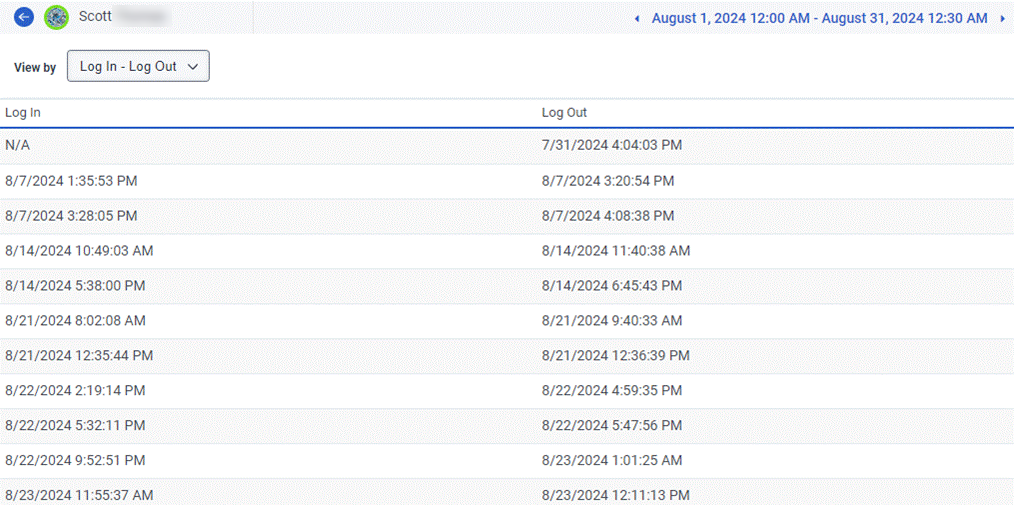Vue d'ensemble de la facturation du modèle de licences concurrentes
Dans un modèle de licence simultanée, Genesys facture le nombre maximum (pic) d'utilisateurs simultanés au cours d'une période de facturation. Pour prendre en charge les changements d'équipes, nous ignorons les pics d'utilisation de moins de 30 minutes. Les pics d'utilisation peuvent se produire à des intervalles non contigus. Le type facturé par est la licence de niveau PureCloud la plus élevée qui leur a été attribuée au cours de la période facturation. Les calculs de simultanéité sont limités à une seule organisation Genesys Cloud. Nous ne prenons pas en charge les calculs de concurrence entre plusieurs organisations.
Si vous sélectionnez un modèle de licence simultanée, tous les utilisateurs de Genesys Cloud CX 1, Genesys Cloud CX 2, Genesys Cloud CX 3 ou Genesys Cloud CX 4 bénéficient d'une licence simultanée.
Calcul de la simultanéité
Les utilisateurs qui détiennent une certaine licence pendant la période d'utilisation sont éligibles pour le calcul de la concurrence.
Pour calculer la concurrence, Genesys procède comme suit :
- Examinez toutes les tranches de temps pour déterminer combien d'utilisateurs, parmi l'ensemble des utilisateurs, étaient connectés à ce moment-là. Pour ce faire, nous utilisons les données de présence de l'API.
- Par exemple :
- Temps A, 500 utilisateurs
- Heure B, 503 utilisateurs
- Par exemple :
- Créez un ensemble de données indiquant toutes les quantités et la durée (ou le nombre de tranches d'échantillons).
- Par exemple :
- 500 utilisateurs, 31 minutes
- 503 utilisateurs, 6 minutes
- Par exemple :
- Abandonnez toutes les quantités qui n'accumulent pas une quantité de temps non contiguë d'au moins 30 minutes.
- Par exemple :
- 500 utilisateurs, 31 minutes (heures de pointe)
503 utilisateurs, 6 minutes
- Par exemple :
- Étant donné que les 500 utilisateurs pendant 31 minutes ne sont pas nécessairement contigus, le nombre réel d'utilisateurs discrets dans ce pic pourrait être bien supérieur à 500 utilisateurs. Par conséquent, nous construisons un ensemble de données des utilisateurs qui étaient présents dans le plus grand nombre de tranches de temps jusqu'à ce que nous atteignions le pic. Nous éliminons ensuite les utilisateurs qui se trouvent en dessous de ce seuil.
Rapprochement en libre-service
Pour comprendre pourquoi un utilisateur donné a été inclus dans ce décompte, procédez comme suit :
- Pour vérifier la liste des utilisateurs comptabilisés, télécharge les rapports d'utilisation simultanée. Note: Tous ces utilisateurs seront connectés en fonction des données analytiques.
- À l'exception du module complémentaire WEM, ces utilisateurs auront eu la licence en question. Elle est visible sur la page "Personnes". Vous pouvez vérifier leur licence actuelle sur ce site. Note: Il est possible que cette licence ait été modifiée au fil du temps.
- You can check their logged in times for each user in the Agent Status Detail view.
- Par exemple, la vue de l'état d'un utilisateur unique peut ressembler à ceci :

- Par exemple, la vue de l'état d'un utilisateur unique peut ressembler à ceci :
- Si vous souhaitez automatiser la collecte de ces informations, vous pouvez interroger l'API User Status Detail.

